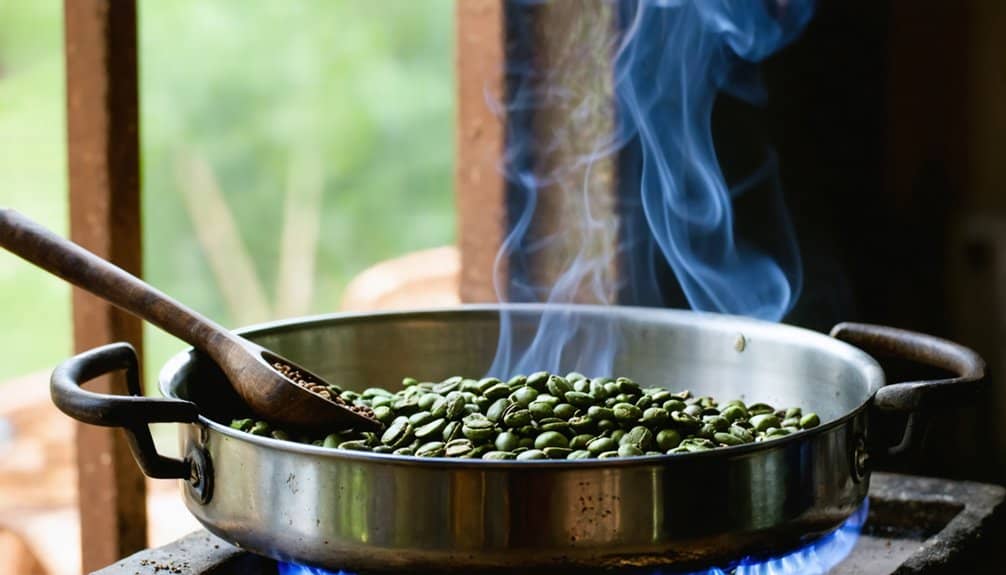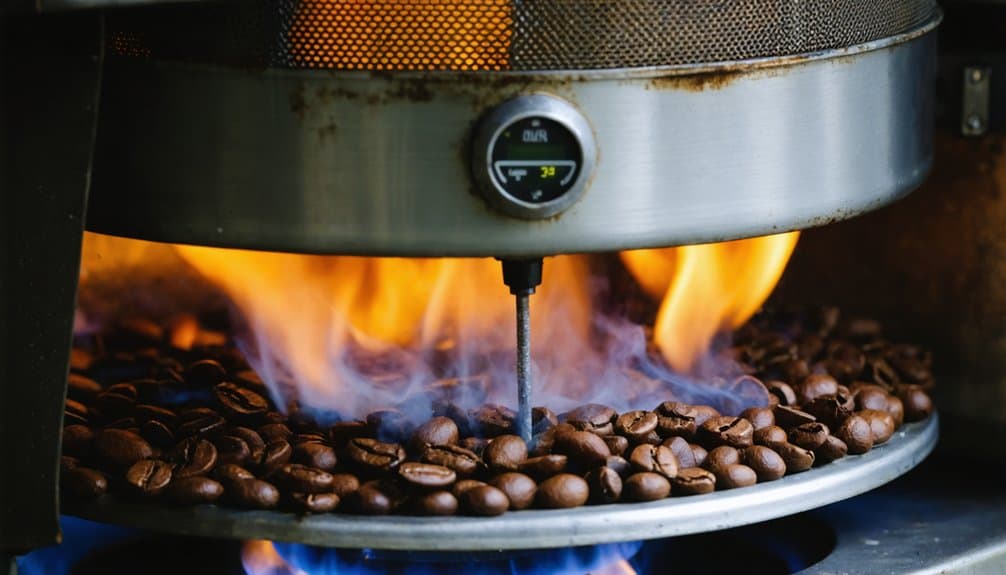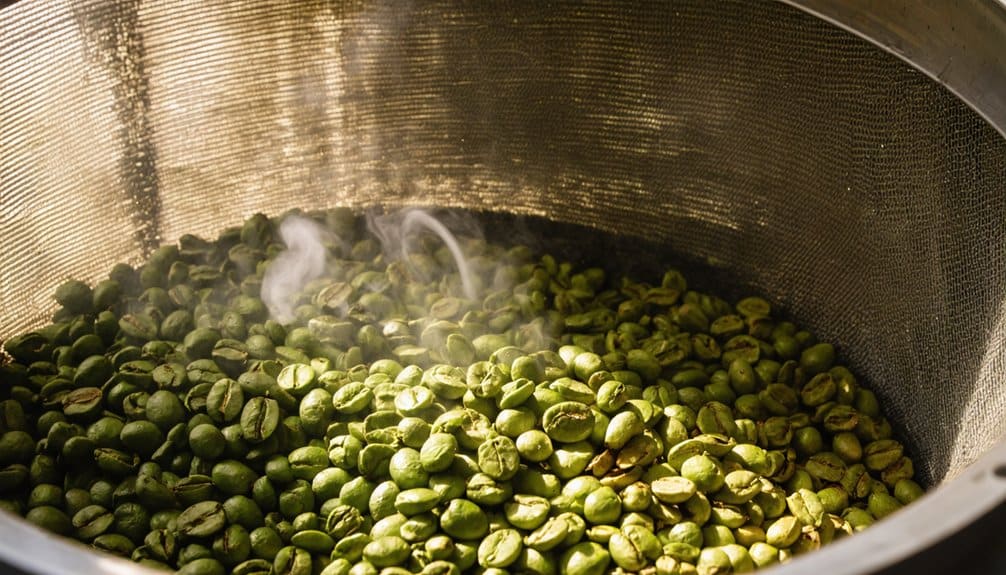To minimize smoke while roasting coffee, you’ll need precise temperature control between 180-205°C and proper airflow management at 60% efficiency.
Install thermal oxidizers or catalytic systems for VOC reduction, and maintain negative air pressure through exhaust fans.
Keep your roasts lighter with shorter roasting times, clean chaff collectors daily, and monitor the Rate of Rise carefully.
Understanding these technical aspects is just the beginning of achieving consistently clean, smoke-free roasts.
Key Takeaways
- Maintain roasting temperatures between 180-205°C for light roasts to minimize smoke production and prevent excessive volatile compound release.
- Install proper ventilation systems with exhaust fans that ensure 10-12 air changes per hour and maintain negative air pressure.
- Keep airflow at 60% efficiency throughout the roasting process, using the cigarette lighter test to verify proper flow.
- Clean chaff collectors and filters daily, while performing weekly deep cleans of the exhaust system to prevent smoke buildup.
- Choose lighter roast profiles with shorter roasting times, as darker roasts produce more smoke during the process.
Understanding Smoke Formation During Coffee Roasting

When coffee beans reach roasting temperatures, organic compounds within them begin to volatilize and combine with steam to form smoke – a process that intensifies during quenching.
You’ll notice this is particularly pronounced when beans contain high moisture content, as the free water between coffee cells rapidly vaporizes during heat transfer.
This smoke contains various emissions including dust, chaff, and VOCs.
Understanding this mechanism is essential for your roasting success.
When you use excessively high charge temperatures, you’re encouraging premature dehydration of the beans’ fibrous structures, leading to increased smoke production.
The key is managing the relationship between temperature, moisture content, and heat transfer to achieve ideal results with minimal smoke generation.
Essential Equipment for Low-Smoke Roasting
To minimize smoke during coffee roasting, you’ll need to install thermal oxidizers or afterburners that can efficiently burn off volatile organic compounds at temperatures exceeding 760°C.
The Avirnaki filter system provides smoke-free roasting without requiring special ventilation or chimney installations.
Your ventilation system must include properly sized exhaust fans and ducts to maintain negative air pressure, preventing smoke from escaping into your roasting space.
When selecting equipment, consider that thermal oxidizers can achieve up to 99% smoke reduction while proper ventilation systems should provide 10-12 air changes per hour for ideal smoke control.
Thermal Oxidizers and Afterburners
Although thermal oxidizers and afterburners serve similar purposes, they’re essential components in modern coffee roasting for achieving minimal smoke output.
When selecting your system, you’ll find thermal oxidizers operate at temperatures around 704°C, while catalytic oxidizers function effectively at 399°C.
Both systems achieve 95-99% destruction of VOCs and particulates.
For indoor roasting operations, you’ll want to evaluate a catalytic oxidizer’s advantages: lower operating costs, quieter performance, and simpler operation.
These systems use catalyst modules to break down pollutants efficiently, making them ideal for both small and large facilities while ensuring compliance with environmental regulations.
The catalytic oxidizer’s condensate evaporation section helps eliminate moisture droplets before the heating process begins.
Proper Ventilation Systems
Three critical components make up an effective ventilation system for low-smoke coffee roasting: double-walled Type B piping, positive pressure venting, and strategic placement near exterior walls.
You’ll need at least 1 inch of clearance for combustibles when installing your Type B venting.
Performing bi-annual inspections will help prevent dangerous flue fires.
For DIY setups, you can optimize efficiency by positioning your roaster near an exterior wall and using a window ventilation system with a wooden plate and pipe thimble.
Incorporate inline fans or air movers to improve airflow control.
Regular maintenance and proper airflow calibration will help minimize smoke production while ensuring safe operation of your ventilation system.
Temperature Control and Heat Management

Since proper temperature control forms the cornerstone of successful coffee roasting, mastering heat management becomes essential for minimizing smoke production.
You’ll want to maintain temperatures between 180-205°C for light roasts and up to 220°C for darker profiles.
Careful attention to bean characteristics and structure will determine your ideal starting temperatures.
Monitor your Rate of Rise (RoR) carefully, aiming for a steady decrease throughout the roast.
If you’re seeking minimal smoke, opt for lighter roasts with shorter roasting times.
Keep a close eye on the turning point and initial Crack, as these moments signal vital temperature adjustments.
Remember, electric roasters offer precise control, while wood-fired options require more careful monitoring to prevent smoke buildup.
Mastering Airflow for Cleaner Roasts
Proper airflow management stands at the heart of achieving clean, smoke-free coffee roasts.
You’ll want to maintain roughly 60% airflow efficiency throughout your roasting process, ensuring adequate smoke and chaff removal while preserving crucial volatile oils.
Since convection heat transfer accounts for at least 70% of the roasting process in drum roasters, maintaining proper airflow is critical.
Use the cigarette lighter trick to dial in your airflow—adjust until the flame bends 60-90 degrees toward the trier hole.
Monitor your rate of rise closely and make necessary adjustments during the roast.
Remember, insufficient airflow leads to smokey flavors, while excessive airflow can cause scorching and tipping.
Keep your exhaust system clean and properly installed with a vertical connection up to 6 meters for ideal results.
Light to Medium Roasting Techniques

When aiming for light to medium roasts, precise temperature control becomes your primary focus for achieving clean, minimal-smoke results.
You’ll want to start with a preheat temperature between 300-400°F, adjusting based on your batch size and bean density.
Increasing your fan settings progressively helps maintain optimal airflow as the roast develops.
For light roasts, maintain temperatures between 177-204°C and end shortly after initial crack.
If you’re targeting medium roasts, push to 210-221°C, approaching but not quite reaching second crack.
Monitor your Rate of Rise carefully – it should be high after the turning point, then moderate as you approach initial crack.
Remember to cool your beans quickly within 4 minutes to lock in your desired profile.
Maintaining Equipment for Smoke Prevention
Beyond mastering roast profiles, maintaining your equipment throughout the day, week, and month directly impacts smoke prevention and roast quality.
To minimize smoke production and maintain superior airflow, focus on these critical maintenance tasks:
- Clean chaff collectors and filters daily to prevent airflow blockages
- Deep clean your exhaust system weekly to remove oil and residue buildup
- Inspect and calibrate temperature probes monthly for precise readings
- Schedule quarterly professional servicing for thorough system evaluation
Regular maintenance guarantees your exhaust system operates at peak efficiency, preventing smoke accumulation while protecting both your equipment and roast consistency.
Remember, a clean roaster is vital for fellow artisan roasters pursuing smoke-free operation.
Using proper safety gear and equipment while performing maintenance helps prevent accidents and ensures thorough cleaning.
FAQs
How Long Should I Wait Between Roasting Batches to Minimize Smoke Build-Up?
You’ll want to wait 10-15 minutes between batches while maintaining active ventilation. This cooling period allows residual smoke to dissipate and your equipment’s temperature to stabilize properly.
Can Different Types of Green Coffee Beans Produce Varying Amounts of Smoke?
You’ll find moisture levels make a world of difference! Darker-roasted beans and those with higher water content typically produce more smoke. Monitor your bean’s initial moisture for ideal temperature control during roasting.
Does Roasting Coffee Outdoors Significantly Reduce Indoor Smoke Accumulation?
You’ll find that outdoor roasting effectively eliminates indoor smoke accumulation since wind disperses emissions naturally. When you’re roasting outside, smoke won’t concentrate in your living space like it would indoors.
What Emergency Procedures Should I Follow if Smoke Becomes Excessive?
Turn off and unplug your roaster immediately, move to safety, and use a fire extinguisher if needed. Don’t hesitate to call emergency services if the smoke’s beyond your control.
Are There Specific Weather Conditions That Can Affect Smoke Production While Roasting?
Yes, cold weather slows your roast and increases smoke, while humidity reduces heat transfer efficiency. You’ll need higher charge temperatures in humid conditions and lower ones during hot weather to maintain control.
The Bottom Line
You’ll find that mastering low-smoke coffee roasting requires precise temperature control between 177°C and 221°C, coupled with ideal airflow management.
By maintaining clean equipment and focusing on light to medium roasts, you’re able to minimize smoke production while developing complex flavor profiles.
Remember: the key to smoke-free roasting lies in the delicate balance of heat application and proper ventilation during those critical initial and second cracks.
